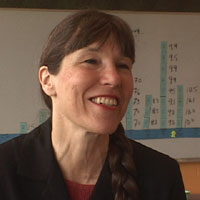Join us for conversations that inspire, recognize, and encourage innovation and best practices in the education profession.
Available on Apple Podcasts, Spotify, Google Podcasts, and more.
 “I think being a sixth-grade teacher is one of the most challenging things I’ve done even as a Ph.D. because usually what an advanced degree gets you just covers a very narrow field. And so, one of the pleasures and challenges, actually, of teaching sixth grade is that you have to learn a lot of background information about all sorts of subjects. I’ve enjoyed it a lot, learning about astronomy and geology. And learning to know the names of my plants. Because as a cellular immunologist, it’s really a different world.”
“I think being a sixth-grade teacher is one of the most challenging things I’ve done even as a Ph.D. because usually what an advanced degree gets you just covers a very narrow field. And so, one of the pleasures and challenges, actually, of teaching sixth grade is that you have to learn a lot of background information about all sorts of subjects. I’ve enjoyed it a lot, learning about astronomy and geology. And learning to know the names of my plants. Because as a cellular immunologist, it’s really a different world.”
Kathleen Vandiver teaches sixth-grade science at the William Diamond Middle School in Lexington, MA, an affluent suburb of Boston. Diamond Middle School’s 700 students perform well above state averages on state tests, and only 4% of them receive a free lunch. Diamond consistently ranks among the top middle schools in Massachusetts.
Kathleen has a Ph.D. in cellular biology. Prior to becoming a teacher, she worked on developing new instruments in biology. All that changed when she accepted an invitation to teach a small unit on the immune system to her son’s fourth-grade class. “I enjoyed it so much that it made me think about teaching, which I hadn’t considered beforehand. It was a real turning point.”
 Lesson at a Glance:
Lesson at a Glance:
Curriculum: Exploring with Wisconsin Fast Plants, Kendall/Hunt Publishing Company
Grade: Sixth
Topic: Variation, Heredity, and Evolution
Kathleen, like Sally Florkiewicz in Program Four, worked with Fast Plants; however, where Sally used them to illustrate the plant life cycle to her third graders, Kathleen used them to demonstrate variation among plant populations to her sixth graders.
Kathleen explained that most of the setup for the lesson took place early in the year when she was showing her students how to do a controlled experiment. In that activity, she had each of her students care for six Fast Plants: two served as the controls, two had low doses of salt in their water, and the final two had high doses of salt in their water. Her students watered the plants using graduated cylinders and measured and recorded the height, number of leaves, and number of flowers on each of the plants for a period of several weeks. “What was really interesting was they weren’t sure whether salt was doing anything because some kids’ high-salt plants were the tallest of their six,” Kathleen commented.
For the activity taped for Session 5, Kathleen’s students measured the heights of a group of plants they had been growing. They recorded the height of each plant on a magnet, and posted the magnets on a graph at the front of the board. In total, the class measured the heights of 166 plants, and, after graphing them, they calculated the average and range heights of the population. The graph illustrated the wide variability in the population, and Kathleen asked her students to speculate on the cause of it: Was the range due to environmental or genetic causes? The class then considered the potential advantages and disadvantages of being a short or tall plant in the population, before discussing ways that the height of the population could change in future generations.
Kathleen’s students then calculated the average for just three plants, and then ten and twenty plants, to illustrate how misleading the data could be if the sample was too small. “We’d like to see at what point does the average reflect what we think is the true average,” explained Kathleen.
The goal was for her students to realize that they need to consider sample size as part of the scientific method. “In elementary school, when you’re trying to teach the general idea of an experiment, you must start off very simply,” said Kathleen, “but at some point, kids need to understand the importance of sample size.”
Kathleen added that an understanding of the scientific method in general, and of sample size in particular, encourages a healthy degree of skepticism in students about things they read in newspapers, claims for ads, etcetera – “If they don’t see that there’s a lot of good scientific method there, they will know not to take it for fact.”
 Lesson Goals:
Lesson Goals:
Consider the goals for this lesson as listed above. How can you create a lesson appropriate for your classroom that will fulfill similar goals?